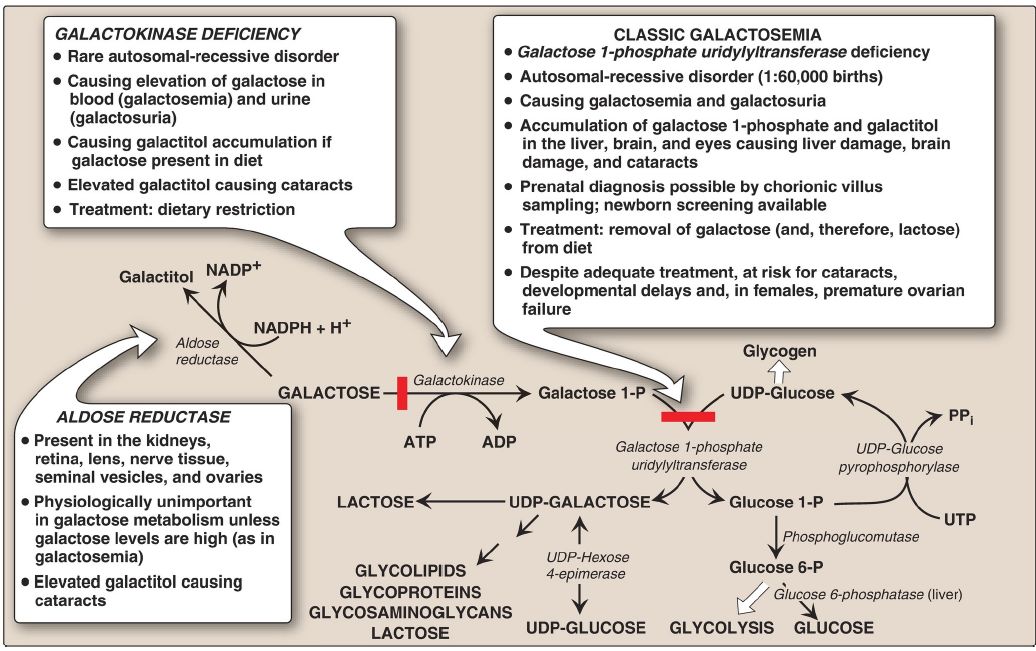


 النبات
النبات
 الحيوان
الحيوان
 الأحياء المجهرية
الأحياء المجهرية
 علم الأمراض
علم الأمراض
 التقانة الإحيائية
التقانة الإحيائية
 التقنية الحيوية المكروبية
التقنية الحيوية المكروبية
 التقنية الحياتية النانوية
التقنية الحياتية النانوية
 علم الأجنة
علم الأجنة
 الأحياء الجزيئي
الأحياء الجزيئي
 علم وظائف الأعضاء
علم وظائف الأعضاء
 الغدد
الغدد
 المضادات الحيوية
المضادات الحيوية|
Read More
Date: 12-12-2021
Date: 10-11-2021
Date: 24-11-2021
|
Galactose Metabolism
The major dietary source of galactose is lactose (galactosyl β-1,4-glucose) obtained from milk and milk products. [Note: The digestion of lactose by β-galactosidase (lactase) of the intestinal mucosal cell membrane .] Some galactose can also be obtained by lysosomal degradation of glycoproteins and glycolipids. Like fructose (and mannose), the transport of galactose into cells is not insulin dependent.
A. Phosphorylation
Like fructose, galactose must be phosphorylated before it can be further metabolized. Most tissues have a specific enzyme for this purpose, galactokinase, which produces galactose 1-phosphate (Fig. 1). As with other kinases, ATP is the phosphate donor.

Figure 12.5 Metabolism of galactose. UDP and UTP = uridine di- and triphosphates; P = phosphate; PPi = pyrophosphate; NADP(H) = nicotinamide adenine dinucleotide phosphate; ADP = adenosine diphosphate.
B. Uridine diphosphate–galactose formation
Galactose 1-phosphate cannot enter the glycolytic pathway unless it is first converted to uridine diphosphate (UDP)-galactose (Fig. 2). This occurs in an exchange reaction, in which UDP-glucose reacts with galactose 1-phosphate, producing UDP-galactose and glucose 1-phosphate (see Fig. 1). The reaction is catalyzed by galactose 1-phosphate uridylyltransferase (GALT). [Note: The glucose 1-phosphate product can be isomerized to glucose 6-phosphate, which can enter glycolysis or be dephosphorylated.]

Figure 2: Structure of UDP-galactose. UDP = uridine diphosphate.
C. UDP-galactose conversion to UDP-glucose
For UDP-galactose to enter the mainstream of glucose metabolism, it must first be isomerized to its C-4 epimer, UDP-glucose, by UDP-hexose 4- epimerase. This “new” UDP-glucose (produced from the original UDPgalactose) can participate in biosynthetic reactions (for example, glycogenesis) as well as in the GALT reaction. [Note: See Fig. 1 for a summary of the interconversions.]
D. UDP-galactose in biosynthetic reactions
UDP-galactose can serve as the donor of galactose units in a number of synthetic pathways, including synthesis of lactose , glycoproteins , glycolipids , and glycosaminoglycans . [Note: If galactose is not provided by the diet (for example, when it cannot be released from lactose owing to a lack of β-galactosidase in people who are lactose intolerant), all tissue requirements for UDP-galactose can be met by the action of UDP-hexose 4-epimerase on UDP-glucose, which is efficiently produced from glucose 1-phosphate and uridine triphosphate (see Fig. 1).]
E. Disorders
GALT is severely deficient in individuals with classic galactosemia (see Fig. 1). In this disorder, galactose 1-phosphate and, therefore, galactose accumulate. Physiologic consequences are similar to those found in HFI (see p. 138), but a broader spectrum of tissues is affected. The accumulated galactose is shunted into side pathways such as that of galactitol production.
This reaction is catalyzed by aldose reductase, the same enzyme that reduces glucose to sorbitol . GALT deficiency is part of the newborn screening panel. Treatment of galactosemia requires removal of galactose and lactose from the diet. [Note: Deficiencies in galactokinase and the epimerase result in less severe disorders of galactose metabolism, although cataracts are common (see Fig. 1).]



|
|
|
|
دراسة يابانية لتقليل مخاطر أمراض المواليد منخفضي الوزن
|
|
|
|
|
|
|
اكتشاف أكبر مرجان في العالم قبالة سواحل جزر سليمان
|
|
|
|
|
|
|
المجمع العلمي ينظّم ندوة حوارية حول مفهوم العولمة الرقمية في بابل
|
|
|